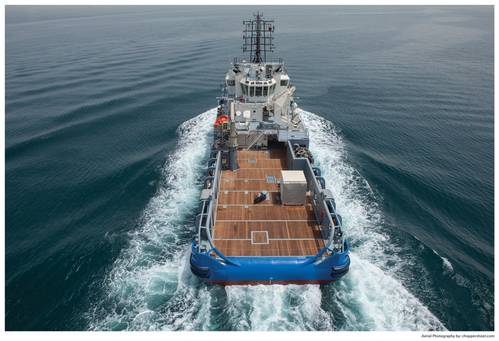Bourbon: Offshore Seismic Survey Vessel Success

The vessel sports a hybrid propulsion system that saves an estimated fuel savings in the range of 30-40% compared to standard vessels. (Photo: choppershoot.com courtesy Bourbon)
Announced in June 2011, Bourbon and CGG entered a five-year charter agreement for a series of six custom newbuild seismic support vessels. Now more than two years later, the third ship in the series, Bourbon Gannet, is due to enter service in the early part of 2014, following the launch of the first two vessels, Bourbon Petrel and Bourbon Fulmar, in summer and autumn 2013, respectively. The remaining three sister vessels are under construction in Dubai’s Grandweld Shipyard, also slated for launch in 2014.
The six Bourbon ships were engineered by naval architecture company Offshore Ship Designers to assist CGG’s offshore seismic operations. The Cyprus-flagged, 53-m vessels boast 50-metric-ton bollard pull capabilities and are designed for following tasks: personnel transportation for crew rotations, equipment transportation, bunkering operations, supply of water and provisions, sewage and sludge transfer, operational protection assistance (anti-collision, clearing transit routes), emergency towing capacity to ensure the continuity of seismic operations and maritime assistance and support during maintenance operations.
Bourbon Petrel has been supporting the CGG Symphony seismic vessel in the Black Sea since July 2013, where it has carried out many refueling operations, including inline bunkering, in addition to towing work and crew rotations. Bourbon Fulmar is currently assisting the Viking Vanquish, a seismic vessel operating in Northern Europe.
Importantly, the six support vessels operate on versatile hybrid propulsion systems to provide optimized fuel efficiency over a diverse range of tasks: diesel-electric power is often better suited for escort operations, while mechanical propulsion is used for maximum power in transit and during operations. The propulsion systems include Berg shaftlines, Caterpillar engines and generators and Techsol electrical systems.
Representatives from Bourbon and CGG declined to say how much the hybrid propulsion hiked the ships’ overall cost, but they did estimate fuel savings in the range of 30-40% compared to standard vessels. Each vessel saves a few thousand dollars per day on fuel thanks to the operational flexibility of the hybrid propulsion systems.
In addition to these advantages, Yves Rastoin, Maritime Director, CGG, said his company reaps a number of other benefits from its partnership with Bourbon. He said Bourbon fit CGG’s need for a “long-term partner of choice” while meeting the specialized nature CGG’s 22 globally active seismic vessels – and at a good price. Furthermore, Rastoin cited Bourbon’s strong track record as a platform on which to develop a long-term relationship. “We selected Bourbon for their experience in vessel series management, and for their capacity to optimize their availability and deliver their high operating standards.”
“Along with our efforts to streamline our fleet of seismic vessels and reduce the number of shipmanagers, CGG has launched a dedicated program for its chartered fleet of support vessels,” Rastoin said. “The series of six specially designed vessels under a long-term charter agreement with Bourbon is the first of its kind for our industry. Given the successful operations already carried out by the Bourbon Petrel and the Bourbon Fulmar, we feel confident about having made the right choice of partner and customized support vessel design for our seismic operations. “
For Bourbon, the newbuilds are encompassed in its “Bourbon 2015 Leadership Strategy” plan, which entails company-wide investments nearing $2 billion (USD) to bolster the group’s global fleet. “The partnership with CGG is entirely consistent with Bourbon’s development strategy, based on a modern, standardized, high-performance fleet and perfectly trained crews, in accordance with our operational excellence goal,” said Rodolphe Bouchet, vice president of business management for Bourbon’s marine services department. “The success of these first seismic support vessels attests to Bourbon’s capacity to assist clients on demanding projects by providing them with quality services in constantly evolving environments and markets.”
Also part of the deal, Bourbon and CGG extended their partnership in a number of other related areas, most specifically safety and training operations: the captains of the Bourbon vessels receive training on CGG’s seismic operations simulator; drills and training exercises focusing on operational quality are held on a regular basis to prepare Bourbon and CGG crews together and to share best practices; and finally, a single contact person at Bourbon is responsible for vessel contract administration - this person is the key client contact on a daily basis.
Main Particulars
Length, o.a. 53.8 m
Breadth, molded 13 m
Depth 6.3 m
Max./Design draft 4.8 m/4 m
Deadweight approx at max. draft 1,360 mt
Bollard pull at Diesel - mechanical mode 40 mt
Bollard pull at boost mode 50 mt
Gross/Net tonnage approx 1,358/407
Type Seismic support vessel. IMT 952
Class: BV
Flag Cyprus. + AUT-UMS
Deck area approx. 230 m2
Max Deck cargo 205 mt
Domestic MDO (@ 97 %) 271 cu. m.
Cargo MDO/Cargo HFO (@ 97%) 77 cu. m./895 cu. m.
Deliverable MDO/HFO cargo 950 cu. m.
Fresh water 121 cu. m.
Ballast water 519 cu. m.
Lub oil 10 cu. m.
Thermal oi 4 cu. m.
Cargo slops 10 cu. m.
Cargo HFO/MDO 2x 200 cu. m./h at 60 m
Cargo MDO 50 cu. m./h at 60 m
Cargo fresh water 50 cu. m./h at 60 m
Ballast/Fire pump 75 cu. m./h a 50 m
Bilge system 50 cu. m./h at 50 m
Accommodations 24 pers. (including 12 passengers)
Main Diesel engines 2 x 1,575 bhp
Auxiliary Diesel generators 3 x 550 kW
Electric motor plant 2 x 350 kW
Main propulsion 2 x Hybrid propulsion package on CP propellers
Bow tunnel thrusters 2 x 300 kW
Emergency generator 1 x 95 kW
Speed/Consumption (at 4m design draft)
Diesel—Mechanical mode 11.8 t/day at 11knots
Diesel—Electrical mode 3 t/day at 6 knots
Boost mode 15.4 t/day at 11.5 knots
(As published in the November/December 2013 edition of Marine Technology Reporter - www.seadiscovery.com)













 August 2024
August 2024



